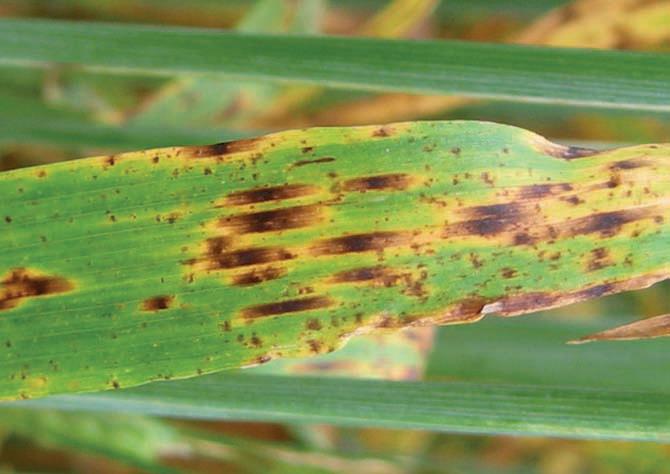The tricky job of reducing ramularia in barley crops
30 April 2020Ramularia is a major worry in barley crops and has risen to the top of the plant health concerns in the spring barley crop.
It is an incredibly complex pathogen which is one of the reasons it has managed to become such a perennial problem. The rapid onset of ramularia spots can swiftly rob the crop of late green leaf area and as a consequence yield and quality. Spots often break out after a stress event such as bursts of sunshine or a critical but stressful growth stage such as flowering. But our understanding of the biology has moved from thinking that we can somehow keep ramularia out and more towards a position where we accept it is there, hidden within the plant and the best management actions are those that prevent it moving from its covert and below the radar growth phases within barley plants into its damaging spot forming phase.
Detailed experimental tracking of infections shows that it is usually present within the seed and moves upwards in the plant as new leaves emerge. Leaf wetness externally also means more moisture in the internal cell spaces so is one factor in more of the pathogen reaching the upper leaves, but is not the only or overriding risk factor on its own. Although spores circulate in the air around crops and can be detected at various points in the season, most of the early ramularia growth in the plant seems to be internal and were it not for the fact that at any moment it can break out into its visible spot forming stage it would not be problematic if it stayed quiet within the barley plants.
Publishing the genome of ramularia has shown what a very near relative it is to Septoria and has confirmed some of the observations about how easily this pathogen grows beneath the host plant’s radar. It has far fewer of the genes that allow disease pathogens to break down cell walls and which therefore cause them to be noticed by the host, so that gives further evidence for the stealthy way it operates. Population studies have also shown how diverse ramularia populations are even within short distances in a field and points to the probability of rapid sexual recombination which backs up another known observation about ramularia – how quickly it has adapted to develop fungicide resistance being the most impactful example.
There are complex chemical signals between the barley host and the disease so ramularia is attuned to picking up the earliest signals that senescence is about to start at which points it produces spots and with them spores and moves to complete its lifecycle and eject from its dying host. But, hedging its bets, it will also leave behind a systemic infection in the seed of its former host to carry forward to future season’s crops.
Known triggers for ramularia moving into its damaging spot forming phase include many unavoidable triggers such as the ones that are weather-related. Bursts of strong sunlight in otherwise overcast days are stressful for example. Early waterlogging is an example where symptoms might be seen early and on lower leaves, but flowering onwards is really the key timing for spots to appear.
Managing ramularia remains hard, especially with the loss of chlorothalonil and varietal resistance is some way off as a tool. Understanding where on the farm the disease occurs and getting really familiar with the symptoms is important in developing a picture of the risks to particular farms and particular fields in the farm. Moist sites are more at risk but with such strong stress triggers, this isn’t the overriding concern. No one sets out to deliberately stress a crop but key avoidable stresses include over-complex spray mixes, nutrient deficiencies and the presence of other diseases.
Fungicide efficacy is limited but prothioconazole retains some efficacy as does the new Revysol triazole which, although not as good as chlorothalonil is an improvement on any other fungicides in trials. Final application stage for crops intended for malting is GS45. Work on folpet and biostimulants in trials is continuing. Their efficacy is variable but where folpet can decrease other stresses it may have a role. The main treatment timing is booting to early ear emergence and has to be before the spots have appeared. Earlier treatments at stem extension in barley have been shown to reduce the DNA loading with ramularia but because of the strong influence of weather and later stresses the link with the amount of ramularia and the final symptoms is weak.
Focusing on not stressing crops and on the T2 fungicides remains key.
Fiona Burnett SRUC, for the Farm Advisory Service
Sign up to the FAS newsletter
Receive updates on news, events and publications from Scotland’s Farm Advisory Service

